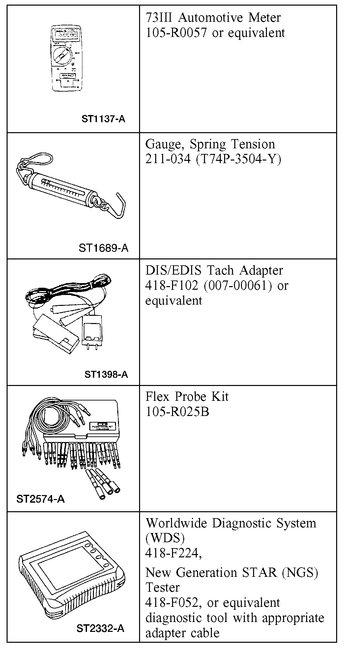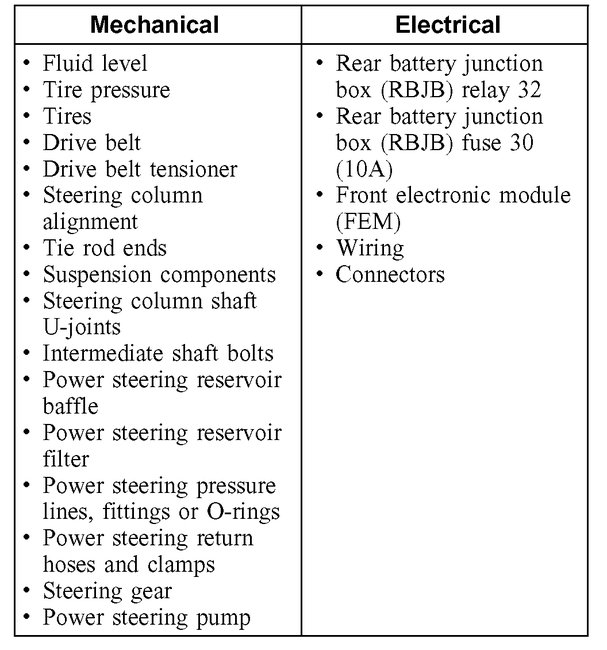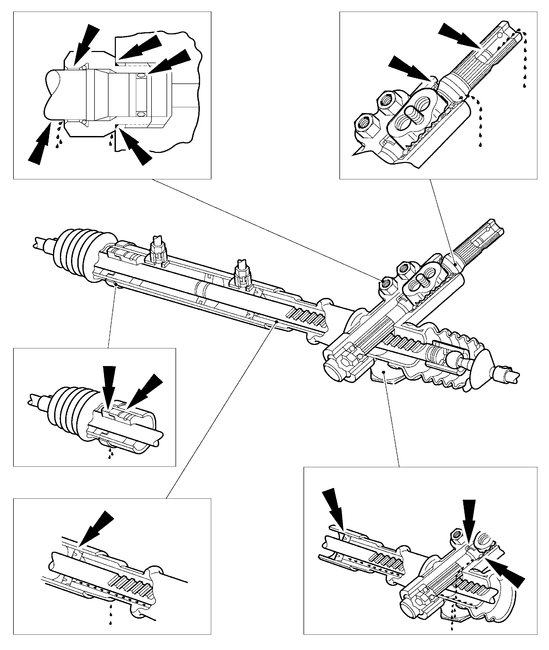Hi and thanks for using 2CarPros. Com.
Your vehicle has variable assist power steering. Based on your description, it sounds like you are getting some assist, but not the full assist that should be there when under two mph.
Here is a definition of the system which explains how it works. Additionally, I attached directions for checking the system to find the problem. However, the test requires specialized tooling. Regardless, I attached it in case you have the tools and want to give it a try. All attached pictures correlate with these directions.
____________________________________________________________
INSPECTION AND VERIFICATION
Steering System
Special Tool(s)
Material
Principles of Operation
Variable Assist Power Steering (VAPS)
The VAPS system controls the level of power assistance available to the driver based on vehicle speed. Below 3.2 km/h (2 mph), full power steering assist is provided to lessen steering efforts and increase maneuverability. Between 3.2 km/h (2 mph) and 191 km/h (119 mph), steering assist will decrease gradually at a calibrated rate to raise steering efforts for increased directional stability and greater road feel. Above 191 km/h (119 mph), steering assist is constant.
The Front Electronic Module (FEM) outputs a pulse-width-modulated (PWM) current to the control valve actuator. The control valve actuator controls the hydraulic valve that determines the amount of hydraulic assist provided to the steering gear. The amount of assistance provided varies with the control valve actuator current, which is based on vehicle speed according to a look-up table internal to the FEM. The FEM pulse-width modulates the control valve actuator current to provide the desired amount of assistance. The amount of hydraulic steering assistance provided by the VAPS subsystem is proportional to the average control valve current.
The vehicle speed is provided to the FEM through the Standard Corporate Protocol (SCP) network from the Anti-Lock Brake System (ABS).
The engine rpm is provided to the FEM through the SCP network from the Powertrain Control Module (PCM). The FEM uses the engine rpm to determine if the engine is running. The FEM will only output control valve actuator current when the engine is running to minimize noise, vibrator, or harshness when the engine is off. The FEM will assume the engine is running only if the engine rpm is greater than 100 rpm.
Upon engine start, the FEM will provide a 200 millisecond full-on pulse followed by a 150 millisecond full-off pulse to the control valve actuator. Normal VAPS system operation will begin after this cleaning stroke is complete. In an event that the rpm signal is invalid from the PCM (less than 100 rpm), and the vehicle speed is less than 1.6 km/h (1 mph), the VAPS system will not carry out the cleaning stroke or apply current to the control valve actuator. When the engine speed exceeds 100 rpm, the system carries out the cleaning stroke and begins applying calibrated current to the actuator.
Inspection and Verification
1. Verify the customer concern.
2. Visually inspect for obvious signs of mechanical damage.
Visual Inspection Chart
3. NOTE: The 3 areas that should be inspected for possible contamination are the power steering reservoir filter, flow control and pressure relief valve in the pump, and the check valve in the inlet port on the power steering gear (if equipped).
Inspect the power steering fluid for the following conditions:
Aerated or foamy: Purge the power steering system.
Overheating or contamination: Flush the power steering system.
4. Check the power steering system for fluid leaks.
Check the power steering fluid level.
NOTE: It may be necessary to add power steering fluid to achieve the correct level.
With the ignition OFF:
Wipe off the power steering pump, power steering pressure hose, power steering return hose, power steering fluid cooler, hose assembly and steering gear.
CAUTION: Do not hold the steering wheel at the stops for an extended amount of time. Damage to the power steering pump can occur.
Start the engine and turn the steering wheel from stop-to-stop several times and check for leaks.
If a fluid leak from the steering line-to-steering gear clamp plate is evident, refer to Power Steering Pump.
5. Inspect the power steering pressure and return hoses, fittings and O-rings for leaks.
If a leak is detected at a power steering pressure or return hose, install a new hose.
If a leak is detected between a fitting nut, seal the fitting nut using a Teflon seal.
If a leak is detected at a fitting or clamp plate, tighten to specification. If leak is still evident, visually inspect the fittings, clamp plate, O-rings, and Teflon seals. Install new as necessary.
If a leak is detected at the power steering reservoir, install a new reservoir.
If a leak is detected at a constant tension spring clamp, verify that the hose is fully installed on the fitting and that the hose clamp is correctly positioned. If the leak remains, install a new screw clamp.
If a leak is detected at a screw clamp joint, tighten the screw clamp. If the leak remains, inspect the tube end and install a new hose.
If a leak is detected at the power steering pump, install a new power steering pump.
NOTE: To inspect for leaks it may be necessary to remove the squeeze-type clamp from the steering gear boots.
6. Inspect the power steering gear for leaks. If a leak is detected at the power steering gear, install a new power steering gear.
7. If an obvious cause for an observed or reported concern is found, correct the cause before proceeding to the next step.
8. If the concern remains after the inspection, connect the diagnostic tool to the Data Link Connector (DLC) located beneath the instrument panel, and select the vehicle to be tested from the diagnostic tool menu. If the diagnostic tool does not communicate with the vehicle:
Check that the program card is correctly installed.
Check the connections to the vehicle.
Check the ignition switch position.
9. If the diagnostic tool still does not communicate with the vehicle, refer to the tester manual.
10. Carry out the diagnostic tool data link test. If the diagnostic tool responds with:
SCP or ISO; all electronic control units no response/not equipped, refer to Information Bus (Module Communications Network).
No response/not equipped for FEM, refer to Information Bus (Module Communications Network).
System passed, retrieve and record the continuous Diagnostic Trouble Codes (DTCs), erase the continuous DTCs and carry out the self-test diagnostics for the FEM.
11. If the DTCs retrieved are related to the concern, go to the Front Electronic Module (FEM) Diagnostic Trouble Code (DTC) Index to continue diagnostics. See: Steering > Diagnostic Trouble Code Tests and Associated Procedures > Front Electronic Module (FEM) DTC Index
12. If no DTCs related to the concern are retrieved, proceed to next step to continue diagnostics.
13. If an obvious cause for an observed or reported concern is found, correct the cause before proceeding to the next step.
14. If the cause is not visually evident, verify the symptom and GO to Symptom Chart. See: Steering > Symptom Related Diagnostic Procedures
____________________________
I noticed that you indicate little knowledge on vehicle repairs. Honestly, this is not a five minute job. It will take some time.
Let me know if this is helpful or if you have other questions.
Take care,
Joe
Images (Click to make bigger)
Friday, August 31st, 2018 AT 5:53 PM






